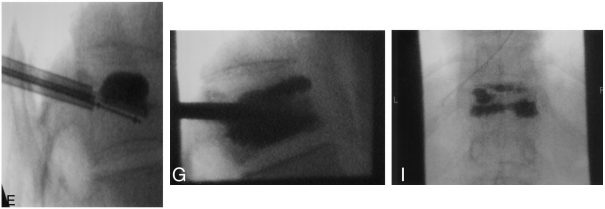MaKyphoplastyBalloonSimulation
Kyphoplasty balloon simulation
Thesis by: tbaAdvisor: Prof. Dr. Nassir Navab
Supervision by: Patrick Wucherer, Philipp Stefan

 Images: Garfin, S. R., Yuan, H. A., & Reiley, M. A. (2001). New technologies in spine: kyphoplasty and vertebroplasty for the treatment of painful osteoporotic compression fractures. Spine, 26(14), 1511-1515.
Images: Garfin, S. R., Yuan, H. A., & Reiley, M. A. (2001). New technologies in spine: kyphoplasty and vertebroplasty for the treatment of painful osteoporotic compression fractures. Spine, 26(14), 1511-1515.
Topic
We are currently working on a simulator for spine surgery. The procedure we focus on is kyphoplasty, a percutaneous, image-guided minimally invasive surgery. This procedure is a recently introduced treatment of painful vertebral fractures which is being performed extensively worldwide. The objective of kyphoplasty is to inject polymethylmethacrylate (PMMA) bone cement under radiological image guidance into the collapsed vertebral body to stabilize it. Before injecting the cement, an inflatable balloon is placed in the vertebral body and subsequently inflated in order to restore the vertebral height and correct the kyphotic deformity caused by the compression fracture. After the balloon is deflated and removed from the vertebral body, the created cavity is filled with PMMA bone cement. The goal of the project is the implementation and validation of a kyphoplasty balloon simulation.Environment
- We offer an intensive supervision, but initiative is very welcome. A working environment will be provided at NARVIS lab.
Requirements
- Knowledge of a programming language/environment, e.g. Matlab, C++, Java, is required.
Contact
| ProjectForm | |
|---|---|
| Title: | Kyphoplasty balloon simulation |
| Abstract: | Kyphoplasty, a percutaneous, image-guided minimally invasive surgery, is a recently introduced treatment of painful vertebral fractures which is being performed extensively worldwide. The objective of kyphoplasty is to inject polymethylmethacrylate (PMMA) bone cement under radiological image guidance into the collapsed vertebral body to stabilize it. Before injecting the cement, an inflatable balloon is placed in the vertebral body and subsequently inflated in order to restore the vertebral height and correct the kyphotic deformity caused by the compression fracture. After the balloon is deflated and removed from the vertebral body, the created cavity is filled with PMMA bone cement. The goal of the project is the implementation and validation of a kyphoplasty balloon simulation. |
| Student: | |
| Director: | Prof. Dr. Nassir Navab |
| Supervisor: | Patrick Wucherer, Philipp Stefan |
| Type: | DA/MA/BA |
| Area: | Registration / Visualization, Medical Imaging, Computer-Aided Surgery |
| Status: | draft |
| Start: | |
| Finish: | |
| Thesis (optional): | |
| Picture: | |